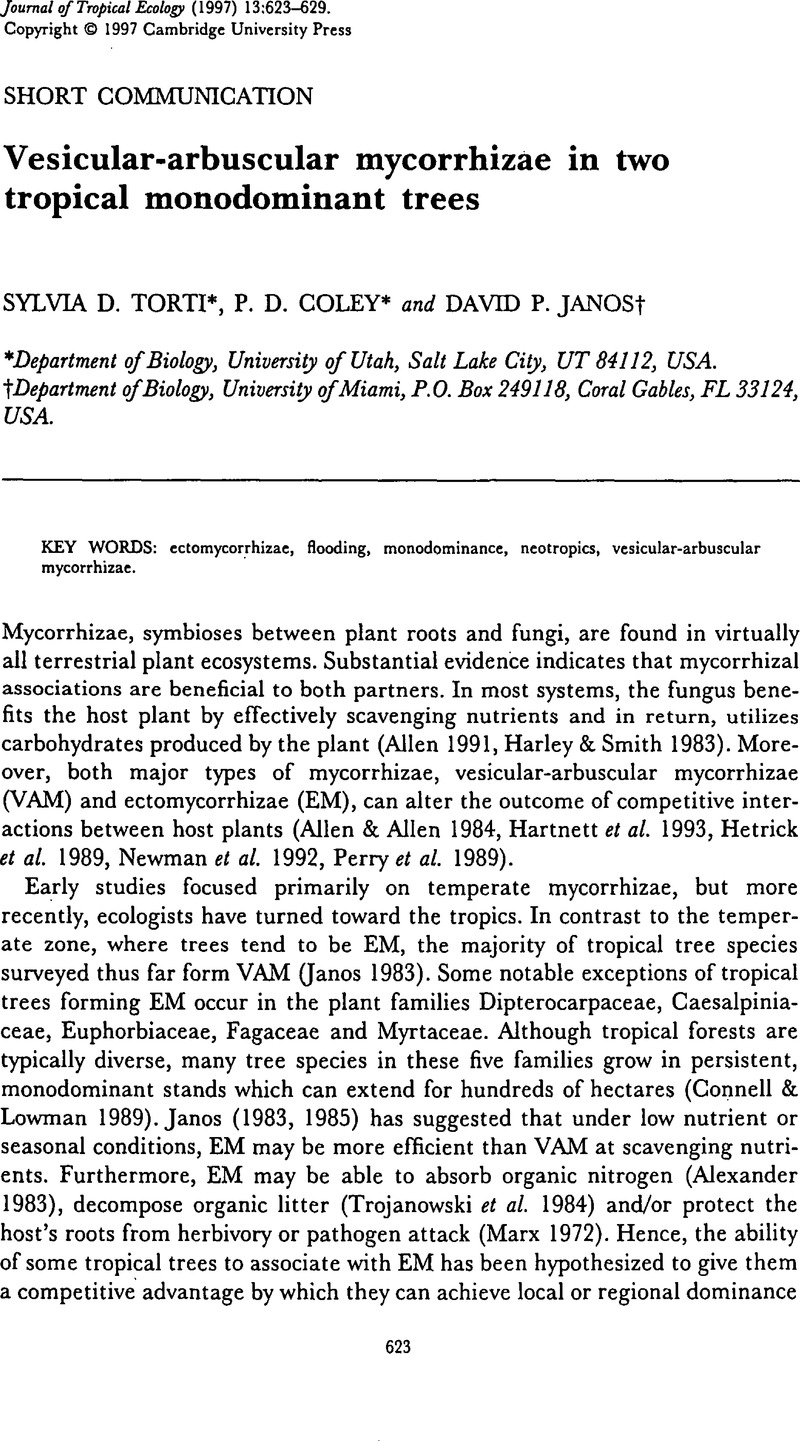Crossref Citations
This article has been cited by the following publications. This list is generated based on data provided by Crossref.
Torti, Sylvia D.
and
Coley, Phyllis D.
1999.
Tropical Monodominance: A Preliminary Test of the Ectomycorrhizal Hypothesis1.
Biotropica,
Vol. 31,
Issue. 2,
p.
220.
Gross, Nicole D.
Torti, Sylvia D.
Feener, Donald H.
and
Coley, Phyllis D.
2000.
Monodominance in an African Rain Forest: Is Reduced Herbivory Important?1.
BIOTROPICA,
Vol. 32,
Issue. 3,
p.
430.
Gross, Nicole D.
Torti, Sylvia D.
Feener, Donald H.
and
Coley, Phyllis D.
2000.
Monodominance in an African Rain Forest: Is Reduced Herbivory Important?1.
Biotropica,
Vol. 32,
Issue. 3,
p.
430.
Torti, Sylvia D.
Coley, Phyllis D.
and
Kursar, Thomas A.
2001.
Causes and Consequences of Monodominance in Tropical Lowland Forests.
The American Naturalist,
Vol. 157,
Issue. 2,
p.
141.
LOPEZ, O. R.
2001.
Seed flotation and postflooding germination in tropical terra firme and seasonally flooded forest species.
Functional Ecology,
Vol. 15,
Issue. 6,
p.
763.
Moyersoen, B.
Becker, P.
and
Alexander, I. J.
2001.
Are ectomycorrhizas more abundant than arbuscular mycorrhizas in tropical heath forests?.
New Phytologist,
Vol. 150,
Issue. 3,
p.
591.
Tawaraya, K.
Takaya, Y.
Turjaman, M.
Tuah, S.J.
Limin, S.H.
Tamai, Y.
Cha, J.Y.
Wagatsuma, T.
and
Osaki, M.
2003.
Arbuscular mycorrhizal colonization of tree species grown in peat swamp forests of Central Kalimantan, Indonesia.
Forest Ecology and Management,
Vol. 182,
Issue. 1-3,
p.
381.
Gehring, Catherine A.
2003.
Growth responses to arbuscular mycorrhizae by rain forest seedlings vary with light intensity and tree species.
Plant Ecology,
Vol. 167,
Issue. 1,
p.
127.
De Grandcourt, Agnès
Epron, Daniel
Montpied, Pierre
Louisanna, Eliane
Béreau, Moïse
Garbaye, Jean
and
Guehl, Jean‐Marc
2004.
Contrasting responses to mycorrhizal inoculation and phosphorus availability in seedlings of two tropical rainforest tree species.
New Phytologist,
Vol. 161,
Issue. 3,
p.
865.
Huebner, Cynthia D.
McQuattie, Carolyn
and
Rebbeck, Joanne
2007.
Mycorrhizal associations in Ailanthus altissima (Simaroubaceae) from forested and non-forested sites1.
The Journal of the Torrey Botanical Society,
Vol. 134,
Issue. 1,
p.
27.
Janos, David P.
2007.
Plant responsiveness to mycorrhizas differs from dependence upon mycorrhizas.
Mycorrhiza,
Vol. 17,
Issue. 2,
p.
75.
Medina, Ernesto
2007.
Functional Plant Ecology, Second Edition.
Vol. 20073278,
Issue. ,
Peh, Kelvin S.-H.
Lewis, Simon L.
and
Lloyd, Jon
2011.
Mechanisms of monodominance in diverse tropical tree-dominated systems.
Journal of Ecology,
Vol. 99,
Issue. 4,
p.
891.
Naudé, Y.
van Rooyen, M.W.
and
Rohwer, E.R.
2011.
Evidence for a geochemical origin of the mysterious circles in the Pro-Namib desert.
Journal of Arid Environments,
Vol. 75,
Issue. 5,
p.
446.
Brookshire, E. N. Jack
Thomas, Steven A.
and
Chen, Han YH.
2013.
Ecosystem Consequences of Tree Monodominance for Nitrogen Cycling in Lowland Tropical Forest.
PLoS ONE,
Vol. 8,
Issue. 7,
p.
e70491.
Tawaraya, Keitaro
and
Turjaman, Maman
2014.
Mycorrhizal Fungi: Use in Sustainable Agriculture and Land Restoration.
Vol. 41,
Issue. ,
p.
357.
Barry, Karen M.
Janos, David P.
Nichols, Scott
and
Bowman, David M. J. S.
2015.
Eucalyptus obliqua seedling growth in organic vs. mineral soil horizons.
Frontiers in Plant Science,
Vol. 6,
Issue. ,
Camenzind, Tessa
Homeier, Jürgen
Dietrich, Karla
Hempel, Stefan
Hertel, Dietrich
Krohn, Andreas
Leuschner, Christoph
Oelmann, Yvonne
Olsson, Pål Axel
Suárez, Juan Pablo
and
Rillig, Matthias C.
2016.
Opposing effects of nitrogen versus phosphorus additions on mycorrhizal fungal abundance along an elevational gradient in tropical montane forests.
Soil Biology and Biochemistry,
Vol. 94,
Issue. ,
p.
37.
Tawaraya, Keitaro
and
Turjaman, Maman
2016.
Tropical Peatland Ecosystems.
p.
237.
Johnson, N.C.
Miller, R.M.
and
Wilson, G.W.T.
2017.
Mycorrhizal Mediation of Soil.
p.
47.



